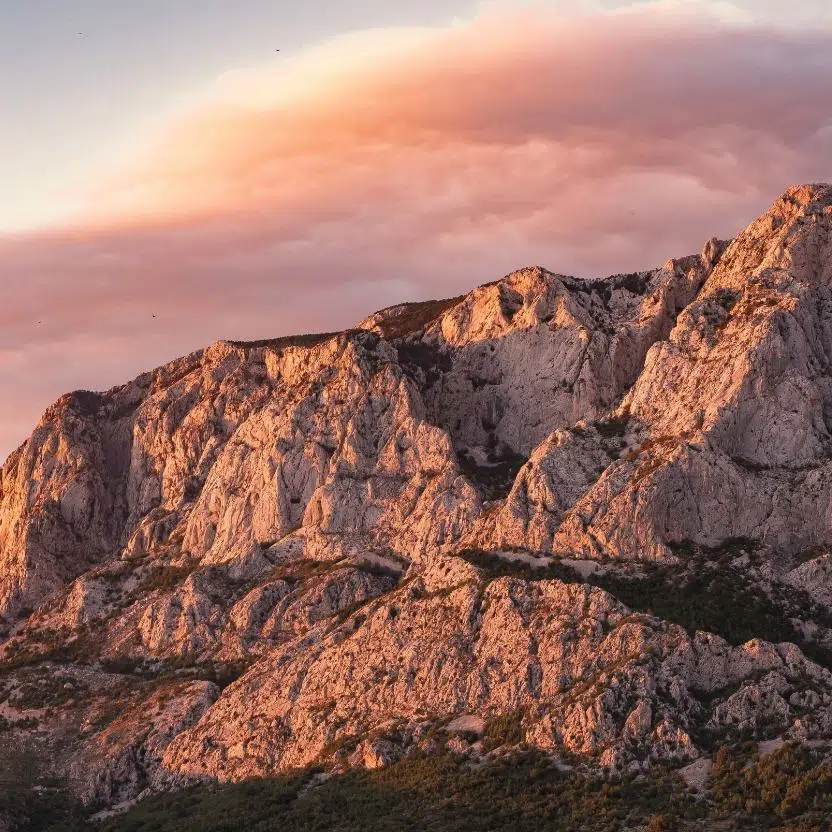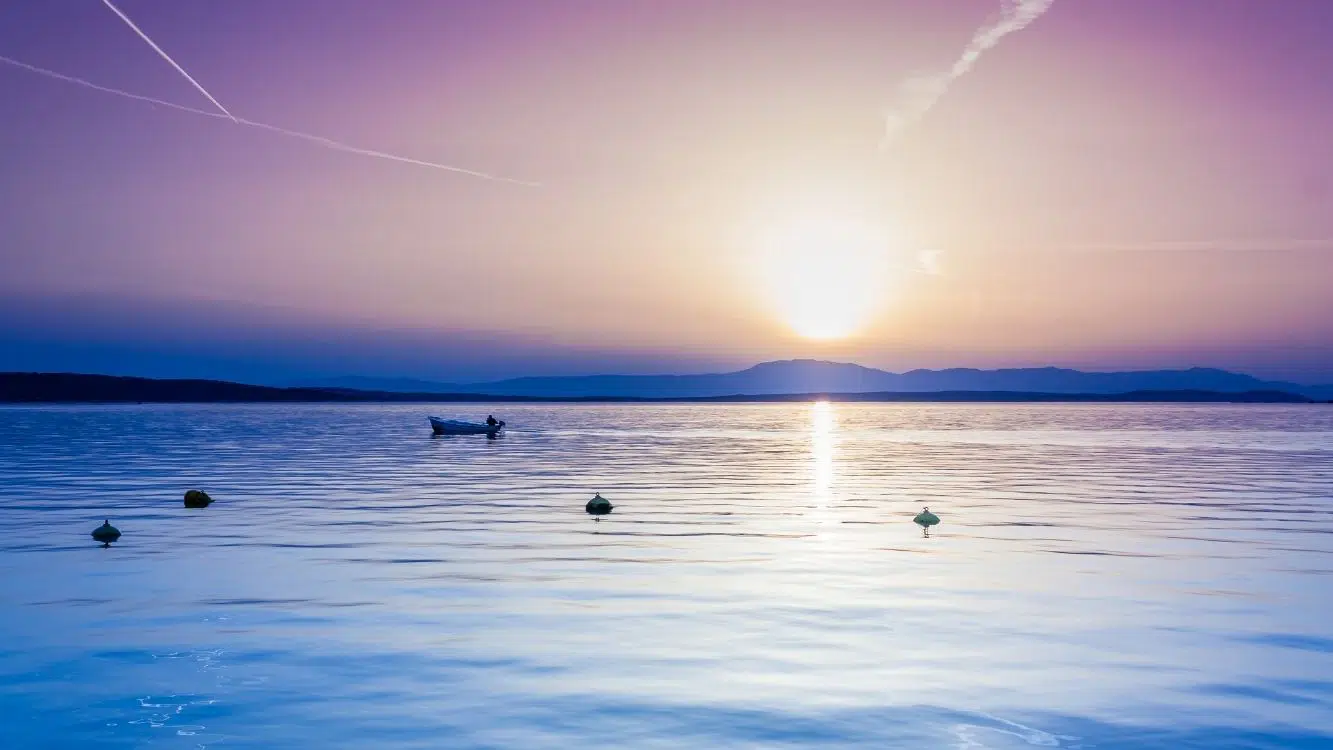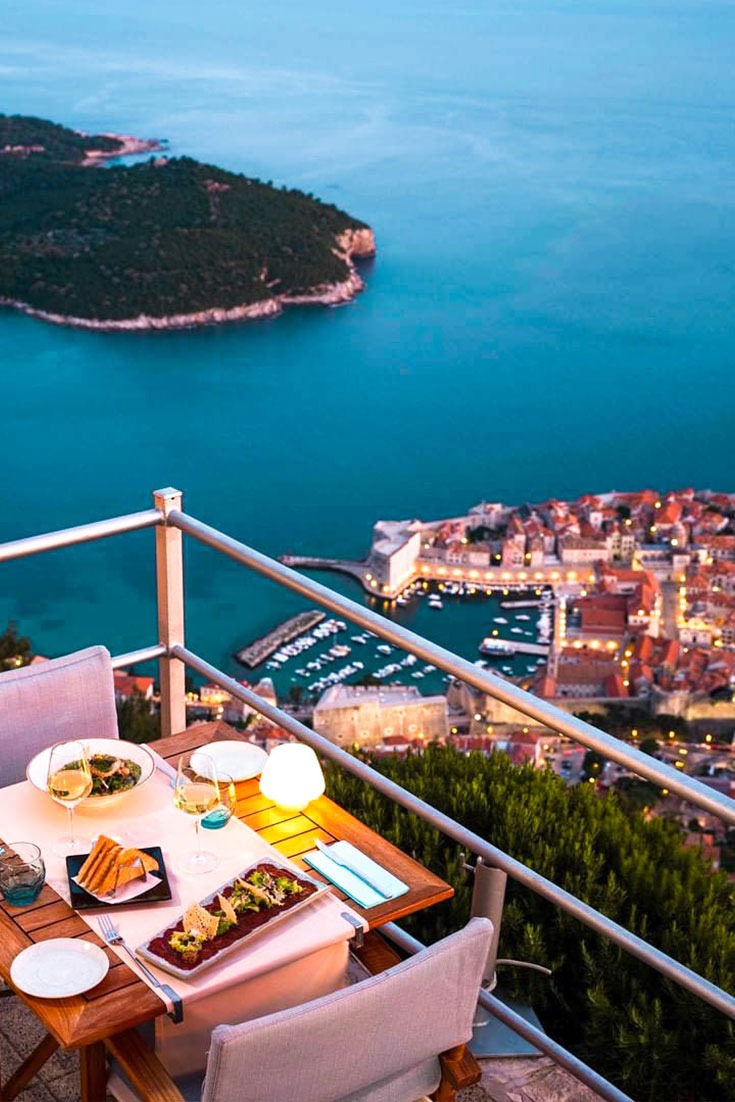The Adriatic Sea, the northernmost arm of the Mediterranean Sea lies between the Balkan and Apennine Peninsulas of the European continent.
| Max. length | 800 km (500 mi) |
| Max. width | 200 km (120 mi) |
| Surface area | 138,600 km2 (53,500 sq mi) |
| Average depth | 252.5 m (828 ft) |
| Max. depth | 1,233 m (4,045 ft) |
| Water volume | 35,000 km3 (2.8×1010 acre⋅ft) |
| Salinity | 38–39 PSU |
The Adriatic was named Adriatike talassa (Greek: Ἀδρıατıϰὴ ϑάλασσα - Adriatic Sea), after the town of Adria located near the mouth of the Po River in Italy. It is assumed that the city of Adria was an important port center for the Etruscans.
The name itself probably comes from the Illyrian word adur, meaning water or sea. Later, the Romans called it Mare Hadriaticum or Sinus Adriaticus (Adriatic Gulf), and the Slavic name since the arrival of the Slavs is the Jadransko more or in short - Jadran.
What is the Adriatic Sea famous for?
The Croatian Adriatic sea is famous for its shades of blue color. From royal blue in the depths of the sea to the turquoise of the shallow pebbly coasts. There is even a benjamin moore teal blue paint named after the Adriatic sea you can use to paint your home.
The Adriatic Sea coast has almost always calm and warm weather in the summer. It has a large amount of hours of sunshine. It is ideal for sunbathing, snorkeling, swimming or just dipping your feet.
With 5835.3 km of gorgeous coastline in Croatia alone, there are an endless number of beautiful beaches to enjoy. Some sandy but mostly pebble beaches.
Adriatic is famous for the array of over 1200 islands, islets, cliffs, and reefs dotting the Adriatic Sea. 96% of them are in the Croatian Adriatic.
A trip to Croatia's amazing natural parks and national parks is sure to be a memorable one, whether you are sailing, hiking, or watching wildlife. Adriatic Sea includes the following parks:
- The Kornati National Park
- Telašćica Nature Park
- Brijuni Islands National Park
- Mljet National Park
- Lastovo Islands Nature Park
Over 7,000 species of plants and animals live in the Adriatic Sea, including endemic species and some of the rarest animals on Earth.
The Adriatic sea coast is home to dozens of charming ports and coastal towns with unique cultural heritage and history. Cities and towns such as Split, Dubrovnik, Pula, Opatija, and Rovinj.
How large is the Adriatic Sea?
The Adriatic Sea is 138,600 km² (53,500 sq mi) in surface area, which is very small when compared to other seas in the world. The Adriatic sea covers only 4.6% of the Mediterranean Sea. It is relatively shallow and semi-enclosed.
It separates two peninsulas of South Europe: the Italian Apennine peninsula and the Balkan peninsula. At its southeastern border between Albania and Italy’s Salento Peninsula the 72-kilometer (45 miles) wide Strait of Otranto connects the Adriatic Sea with the Ionian Sea.
However, it is precisely because of how deeply Adriatic sea indents into the European mainland and its location that makes it a key resource of the countries that surround it, both in the economic and geostrategic sense.
How long is the Adriatic Sea?
It is 800 km (about 500 miles) long. The Adriatic sea has an average width of 160 km (100 miles) and maximum width of 200 km (120 miles). It extends from 39°46’57” - 45°48’18” N and 12°17’14.81″ - 19°34’33.86″ E.
How deep is the Adriatic Sea?
The Adriatic Sea is the shallowest in the extreme northwestern part (Gulf of Trieste, 15 m). The whole North Adriatic basin rarely exceeds a depth of 100 meters (330 ft).
The Middle Adriatic basin is south of the Ancona–Zadar line, with the 270-meter (890 ft) deep Middle Adriatic Pit called Pomo Depression or the Jabuka Pit, after the island of Jabuka. About 150 km long and up to 130 m deep Palagruža Sill (named after the island of Palagruža) stretches from the island of Lastovo to the Gargano peninsula on the east coast of the Apennine Peninsula.
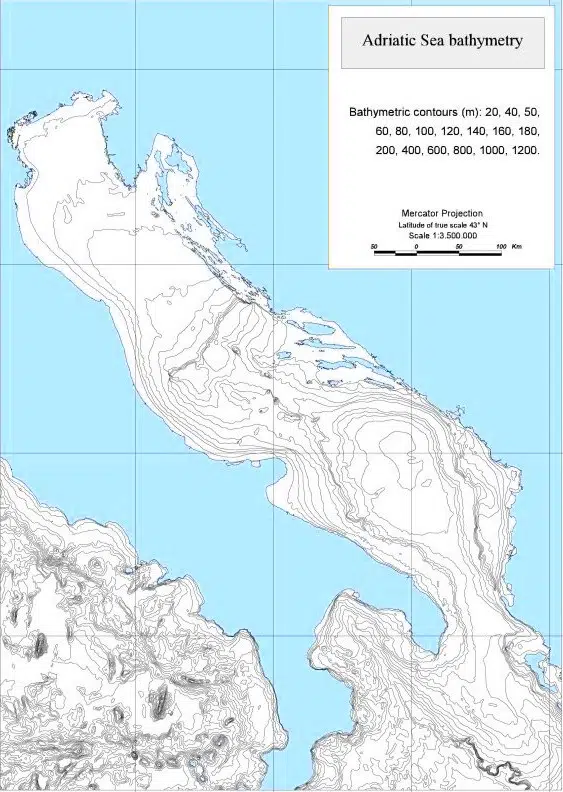
The deepest Adriatic Sea gets is 1233 m (4,045 ft) to the southeast, where the bottom of the Palagruža threshold descends into the South Adriatic basin. Mean depth across the Adriatic sea is 252 m.
What is the largest peninsula in the Adriatic Sea?
The largest peninsula in the Istria peninsula on the east coast. The peninsula is located in the north Adriatic between the Gulf of Trieste and the Kvarner Bay. Three countries have territories on the peninsula: Croatia, Slovenia, and Italy. 89% of the territory belongs to Croatia.
What rivers flow into the Adriatic Sea?
Major rivers discharging into the Adriatic include:
- Neretva (225 km)
- Cetina (101 km)
- Po (652 km)
- Zrmanja (69 km)
- Mirna (53 km)
- Krka (73 km)
- Kupa (297 km)
- Korana (139 km)"
- Adige (410 km)
- Tagliamento (178 km)
- Piave (220 km)
- Livenza (112 km)
- Aterno-Pescara (152 km)
- Reno (212 km)
- Brenta (174 km)
- Sile (95 km)
- Soča (138 km)
- Erzen (109 km)
- Ishmi (79 km)
- Shkumbin (181 km)
- Drini (335 km)
- Mati (115 km)
- Vjosë (272 km)
Are there islands in the Adriatic Sea?
There are a total of about 1,300 islands in the Adriatic Sea. The eastern coast of the Adriatic Sea is rich in islands, most of which are in Croatia (1,246) and Montenegro (48). The largest islands in the Adriatic Sea are Cres (406.63 km²), Krk (406.27 km²), and Brač (394.57 km²).
The Adriatic east coast islands are limestone, except for the islands of Jabuka and Brusnik, which are of volcanic origin, and sandy Susak island. Roughly 50 Croatian islands are permanently inhabited. Krk and Korčula have the most inhabitants, and approximately 130 000 inhabitants live on the Croatian islands. Some of the islands are connected to the mainland with brudges such as Krk Bridge and Maslenica bridge.
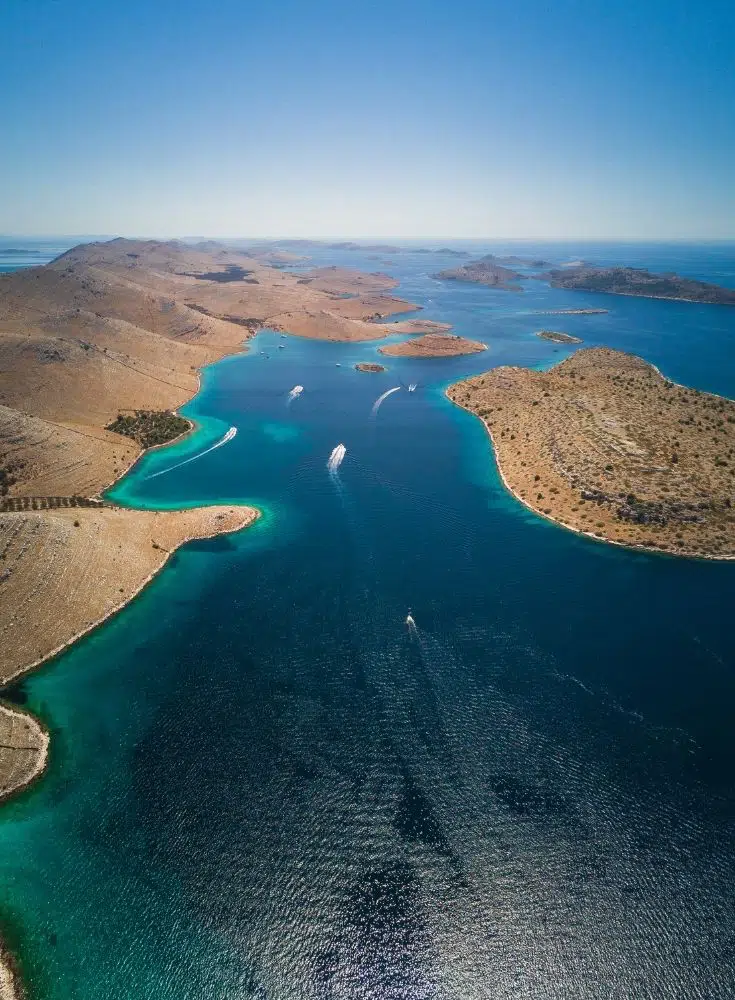
There are fewer islands along the western Italian coast of the Adriatic Sea. With very few islands and only the Monte Conero and Gargano promontories sticking out into the sea, the Apennine peninsular coast is relatively smooth. The most famous are the 117 islands upon which Venice is built. According to the IHO, the northern part of the Greek island of Corfu and the Diapontia Islands lies in the Adriatic Sea which also puts Greece on the Adriatic Sea.
The most notable Islands are:
- Brač
- Korčula
- Vis
- Pag
- Mljet
- Cres
- Krk
- Dugi otok
- Lastovo
- Rab
- Šolta
- čiovo
- Ugljan
- Murter
- Lošinj
- Prežba
- Drvenik Veli
- Pašman
- Silba
- Zeča
- Mrcara
- Olib
- Veliki Brijun
- Ilovik
- Lokrum
- piskera
- Sit
- Tun Veli
- Babac
- Veliki Budikovac
- St. Marcus
- Scolio delle Monache
- Cazziol
- Marinkovac
- Otok Aba Vela
- Santo Stefano
- Tramerka
- Biševo
- Iž
- Vir
- Lopud
- Molat
- Susak
- Šipan
- Ada Bojana
- Koločep
- Prvić
- Crkvica
- Unije
- Zlarin
- Ist
What countries border the Adriatic Sea?
The length of the coastal mainland of the entire Adriatic Sea is 3690 km. It is shared by 6 countries. Countries that border the Adriatic Sea:
- Croatia 1777 km
- Italy 1249 km
- Albania 396 km
- Montenegro 200 km
- Slovenia 47 km
- BiH 21 km
The island coast is 4,164 km long (Croatia has 4,058 km - 97%, Italy 23 km, Albania 10 km, Montenegro 11km). If we combine the coastline of the mainland and islands, 74% of the total Adriatic sea coast is in Croatia. All 6 countries own a part of the Adriatic sea surface as a part of their own respective territorial waters.
How salty is it?
Adriatic Sea salinity varies between 38 and 39 PSU throughout the year. Salinity in the northern Adriatic is smaller (35 ‰ average) than in its southern part (38 ‰ average) due to the inflow of freshwater from many alpine rivers and the Po river. Salinity fluctuations also depend on weather changes: annual (salinity is lower in summer), interannual (changes in water masses between the Adriatic and the eastern Mediterranean), and long-term (slight increase in salinity over the past few decades).
Is the Adriatic Sea warm?
In terms of temperature, the Adriatic is a moderately warm sea. The sea surface temperature is the lowest in February and March, while the highest in August.
The Adriatic sea gets very warm in the summer when the average sea temperature ranges from 22 to 30 °C (72 to 86 °F). Wintertime temperatures run between 12 to 14 °C (54 to 57 °F). The coldest temperatures are found in the extreme north of the Adriatic, where the mean temperature in February drops to 41 degrees Fahrenheit (5 degrees Celsius) in the Gulf of Trieste.
Water in the deepest layers of the Adriatic is almost always warmer than 11–12 degrees Celsius. The main feature of the thermal influence of the sea in the northern Adriatic is its transfer of heat to the atmosphere, which contributes to the increase of air temperature in winter.
To the delight of swimmers in summer, the surface temperature is more even and ranges between 24 and 25 ° C; at a depth of 10 to 30 m, the temperature drops sharply with depth (the so-called thermocline layer), and at greater depths, it takes on a value between 12 and 14 ° C.
Why is the Adriatic Sea so clear?
The Adriatic Sea is very clear. It has high transparency, as much as 56 meters (on the open sea, west of Dubrovnik).
The transparency of the sea is measured with a Secchi disk. The depth to which the Secchi disk is seen is the depth to which the sea is transparent. The highest transparency measured is in the Sargasso sea, where the Secchi plate is visible up to 66.5 meters deep.
The main reason why the Adriatic sea is so clear is the small number of rivers that would obscure it and the karst rocky coast with little soil. The average sea transparency of the Adriatic is 30 m. It is lower in its northwestern part due to less insolation and the influence of the river Po. It grows to the southeast and away from the coast.
Why is the Adriatic Sea so blue?
The Adriatic sea is regarded by oceanographers as a marine desert. The water there contains very few microorganisms. Consequently, sunlight reaches depths of up to 120 meters in some places due to low particle concentrations. As a result, the water appears very clear.
What color is the Adriatic? The color of the Adriatic Sea is in different shades of blue. It ultimately depends on the depth, rock composition, amount of plankton, cloud cover, and cleanliness. The blue color of the Adriatic and its crystal clear sea with a picturesque coast are an irresistible lure for many. Sandy and gravel bottoms sometimes give a wonderful, almost turquoise color.
Is the Adriatic Sea rough?
Waves in the Adriatic appear primarily because of the wind and the direction wind is blowing. Their strength depends on the shape of the coast and its exposure. Typical wave creating winds in Croatia are: bora (Bura) and sirocco (Jugo).
Bora is a north wind, strong, dry and cold. It blows in gusts (abruptly changing direction and speed) and turbulent wind from the mainland. It is stronger and more frequent in the winter but can also occur in summer.
The bora blows for several days, is stronger at night, and can sometimes reach hurricane speeds. Wind speeds of 20 to 35 m / s are frequent, interrupting traffic in exposed places and between the Croatian coast and the islands. The highest bora wind speed of 59 m/s was measured on the Krk bridge.
Bura in sea canals are dangerous for smaller ships because they can appear suddenly, without any sign, and instantly blow with hurricane force. In the open sea, bora sprays seawater into droplets and foam, creating a thin, misty layer, the so-called sea smoke (fumarea). Towards the open sea, the speed of the bora decreases, and the gusts are weaker, but the waves get bigger.
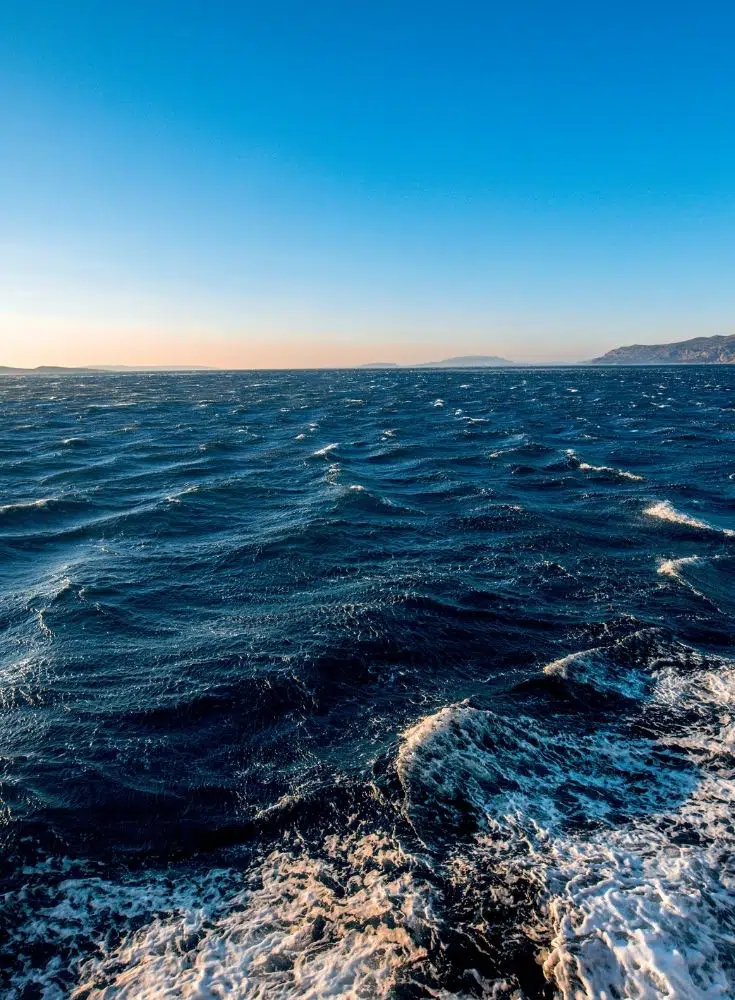
Scirocco (Jugo) wind in the Adriatic from southeast to south blows mostly evenly at 6 to 11 m / s. It sometimes reaches a hurricane strength of 30 m / s. It appears gradually and blows at a uniform speed. It is strongest on the high seas, where it creates large waves that can endanger and even disable shipping. It blows for several days, more often in the cold than in the warm part of the year, within the area of low air pressure located in the western Mediterranean or the Adriatic. Often accompanied by sand from the Sahara, the sirocco brings humid and warm air.
The average wave heights are between 0.5 and 1.5 meters. The waves in the Adriatic can not be compared to tropical waves, where people can surfboard. The highest recorded wave in the Adriatic sea was 10.8 meters high, during the long stormy scirocco. During storms waves can be very strong, threatening boats capsizing along the coast.
The most common surface waves in the Adriatic are caused by Bura and Jugo in winter and the summer northwestern wind. The scirocco typically creates much larger waves, while the bora, although with higher wind speeds, creates lower foamy waves. The waves mix the surface layer of water with the deeper one, and we know from experience that after a summer bora the sea cools down despite the sun shining and the air temperature not dropping much.
How strong are Adriatic sea currents?
Sea currents at the surface layer of the Adriatic Sea (up to 40 meters deep) are warmer and slower along the coast of Croatia and colder and faster along the Italian coast. The currents move in a counterclockwise direction (due to the Earth's rotation). The speeds of these currents are between 10 and 20 cm / s.
Deviations in sea currents occur in different seasons due to changes in temperature, salinity, and the influence of winds.
What animals live in the Adriatic Sea?
The fauna of the Adriatic Sea coincides with the Mediterranean fauna, but it also contains some of its own endemic species.
There are:
- 2597 species of algae (of which 152 are endemic)
- 5647 species of invertebrates (one species endemic)
- 451 species of fish (of which six are endemic)
- Four species of seagrass
- Three species of sea turtles
- Ten species of mammals
The common bottlenose dolphin is the always welcomed sight in the Adriatic. The critically endangered Mediterranean monk seal is a frequent visitor to the Adriatic beaches.
Some species migrate to the Adriatic and stay for extended periods. The largest of these are the fin whale, sperm whale, and Cuvier's beaked whale. Many other marine species migrate to the Adriatic, including basking sharks and manta rays.
Corals recorded in the Adriatic make up about 65% of the known species from the Mediterranean, and 36 species of corals from the Adriatic are endemic to the Mediterranean.
What fish are in the Adriatic?
Most common fish that enhabit the Adriatic sea are: sprat, sardine, pilchard, anchovy, conger, hake, John Dory, sea bass, dentex, gilt-head bream and various types of mullet and common pandora, annular seabream, two-banded sea bream, boops boops, salpa seabream, saddled seabream, striped red mullet, Atlantic horse mackerel, chub mackerel, Atlantic bonito, tuna, the common sole, angler, etc.
From the class of Cyclostomata fish, the sea lamprey lives here, and from the class of cartilaginous some species of sharks, catsharks and various species of rays. All other fish belong to the class Osteichthyes.
Among the crustaceans (Crustacea) found in the Adriatic sea we should mention prawn, lobsters, scampi, spider crab and yellow crab. Mollusks (Mollusca) snails are represented by green ormer, common river snail, patella, purple dye murex.
Adriatic sea has shellfish: flat oyster, Mediterranean mussel, date shell and Mediterranean scallop. Cuttlefish, dwarf bobtail, European squid, jellyfish and octopus are the cephalopods in the Adriatic sea. Several species of sea urchins, sea cucumbers, starfish, sponges also live on the coast.
Are there sharks in the Croatian Adriatic sea?
You might be surprised to learn there are almost 33 species of sharks living in the Adriatic Sea. The vast majority of them are harmless to humans. And many of them are so rare that you would be lucky ever to spot one.
Multiple shark species are widespread like: catsharks, common smooth-hound, spiny dogfish, blue shark and common thresher that grow up to 6 meters. Hammers have only been recorded in the Adriatic a few times. Angelsharks around the Murter Sea and elsewhere are probably one of the last populations in the Mediterranean.
Basking sharks are the largest sharks found in the Adriatic Sea, reaching lengths of 8 meters. Seein one in person would terrify anyone. But actually, baskin sharks are one of three plankton-eating shark species and harmless to humans.
There are only two species dangerous for humans in the Adriatic sea:
Shortfin Mako Shark - also known as the Blue Pointer or Bonito Shark. Large, powerful, and fast, this shark is a favorite for big game anglers around the world because of its speed and agility.
Great White Shark - Known for its unprovoked attacks on humans, Great White Sharks are the world's most feared sharks. Their size can reach more than six meters (20 ft), weight up to two tons, and speed up to 16 mph makes them fearsome predators. Great white sharks certainly enter the Adriatic or are constantly inhabiting it, as evidenced by more than 60 confirmed encounters on the east coast in the last 150 years.
